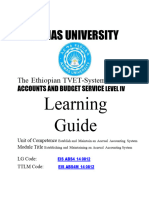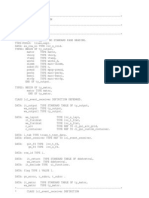0 ratings0% found this document useful (0 votes)
225 viewsDatabase Design Using The REA Data Model
Uploaded by
Dan RyanCopyright
© © All Rights Reserved
Available Formats
Download as PDF, TXT or read online on Scribd
0 ratings0% found this document useful (0 votes)
225 viewsDatabase Design Using The REA Data Model
Uploaded by
Dan RyanCopyright
© © All Rights Reserved
Available Formats
Download as PDF, TXT or read online on Scribd
You are on page 1/ 9
Database Design Using the REA
Data Model
Chapter 17
Copyright © 2015 Pearson Education, Inc. 17-1
Learning Objectives
• Discuss the steps for designing and
implementing a database system.
• Use the REA data model to design an AIS
database.
• Draw an REA diagram of an AIS database.
• Read an REA diagram and explain what it
reveals about the business activities and policies
of the organization being modeled.
Copyright © 2015 Pearson Education, Inc.
17-2
Database Design Process
Copyright © 2015 Pearson Education, Inc.
17-3
Data Modeling
• Process of defining a database so that it
faithfully represents all aspects of the
organization, including its interactions with the
external environment.
▫ Entity-relationship (E-R) diagrams
▫ REA data model
Copyright © 2015 Pearson Education, Inc.
17-4
REA Modeling
• Resources
▫ Things that have economic value to the
organization (e.g., inventory, cash)
• Events
▫ Various business activities that management
wants to collect information on
• Agents
▫ People and organizations that participate in events
(both internal (e.g., employees) and external (e.g.,
customers/vendors) to the organization)
Copyright © 2015 Pearson Education, Inc.
17-5
REA Basic Template
Copyright © 2015 Pearson Education, Inc.
17-6
Creating an REA Model
• Identify relevant events
▫ Give-get exchange (economic duality)
• Identify resources and agents
▫ Resource reduced in give event
▫ Resource acquired in get event
• Determine cardinalities of relationships
▫ Nature of the relationship between the two
entities
Copyright © 2015 Pearson Education, Inc.
17-7
Cardinality Notation Methods
• Graphical symbols
▫ Graphical symbols represent minimum–
maximum cardinalities
• (Min, Max) notation
▫ Pairs representing the minimum–maximum
cardinalities
• UML notation
▫ Pairs representing the minimum–maximum
cardinalities
• Maximums only (Microsoft Access)
Copyright © 2015 Pearson Education, Inc.
17-8
Key Terms
• Data modeling • Minimum cardinality
• Entity-relationship (E-R) • Maximum cardinality
diagram • One-to-One (1:1) relationship
• REA data model • One-to-Many (1:N)
• Resources relationship
• Events • Many-Many (M:N)
• Agents relationship
• Cardinalities
Copyright © 2015 Pearson Education, Inc. 17-9
You might also like
- Activity No. 1 - Cost, Concepts and ClassificationsNo ratings yetActivity No. 1 - Cost, Concepts and Classifications4 pages
- Foundations in Accounting: Maintaining Financial RecordsNo ratings yetFoundations in Accounting: Maintaining Financial Records33 pages
- Lecturenote - 1343108412AUDITING PRINCIPLES AND PRACTICES I100% (1)Lecturenote - 1343108412AUDITING PRINCIPLES AND PRACTICES I108 pages
- Chapter 1: The Demand For Audit and Other Assurance ServicesNo ratings yetChapter 1: The Demand For Audit and Other Assurance Services32 pages
- AIS Romney 2006 Slides 15 Database Design Using The REANo ratings yetAIS Romney 2006 Slides 15 Database Design Using The REA138 pages
- Chapter 3 AIS System Development & DocumentationNo ratings yetChapter 3 AIS System Development & Documentation22 pages
- Establish and Maintain Accural Accounting SystemNo ratings yetEstablish and Maintain Accural Accounting System26 pages
- Accounting Software Application Comprehensive PROJECTNo ratings yetAccounting Software Application Comprehensive PROJECT11 pages
- Fundamental Accounting I: Chapter Two Accounting Cycle For Service-Giving BusinessNo ratings yetFundamental Accounting I: Chapter Two Accounting Cycle For Service-Giving Business14 pages
- Advanced Accounting 11 Ed Chapter 2 PowerPointsNo ratings yetAdvanced Accounting 11 Ed Chapter 2 PowerPoints26 pages
- Auditing The Payroll and Personnel Cycle: Prepared By: Nur Ellina BT Shamsuri (2014270102)No ratings yetAuditing The Payroll and Personnel Cycle: Prepared By: Nur Ellina BT Shamsuri (2014270102)21 pages
- Assignment ON Ifrs1-First Time Adoption of IfrsNo ratings yetAssignment ON Ifrs1-First Time Adoption of Ifrs46 pages
- Securities Markets: Charles P. Jones, Investments: Analysis and Management, Sixth Edition, John Wiley & SonsNo ratings yetSecurities Markets: Charles P. Jones, Investments: Analysis and Management, Sixth Edition, John Wiley & Sons15 pages
- Accounting Information Systems: An Overview100% (1)Accounting Information Systems: An Overview85 pages
- CH - 1 AUDITING PRINCIPLES AND PRACTICES-II STNo ratings yetCH - 1 AUDITING PRINCIPLES AND PRACTICES-II ST10 pages
- CHAPTER SIX - Doc Internal Control Over CashNo ratings yetCHAPTER SIX - Doc Internal Control Over Cash7 pages
- Acca Aa Audit and Assurance: Control Activities100% (1)Acca Aa Audit and Assurance: Control Activities8 pages
- Audit of The Capital Acquisition and Repayment CycleNo ratings yetAudit of The Capital Acquisition and Repayment Cycle32 pages
- @4 Auditing and Assurance Services - WSUNo ratings yet@4 Auditing and Assurance Services - WSU125 pages
- Chapter One: Investments and Capital Allocation Framework 1.1. The Investment Environment-An IntroductionNo ratings yetChapter One: Investments and Capital Allocation Framework 1.1. The Investment Environment-An Introduction10 pages
- Chapter 3 Costing Methods The Costing of Resource OutputsNo ratings yetChapter 3 Costing Methods The Costing of Resource Outputs27 pages
- Term Paper On Accounting & Audit Fraud An Empirical Study by MD Ashraful Rahman 220201015No ratings yetTerm Paper On Accounting & Audit Fraud An Empirical Study by MD Ashraful Rahman 22020101533 pages
- 2021 08 23 21 39 46 A031191111 Accounting Theory Construction PPTNo ratings yet2021 08 23 21 39 46 A031191111 Accounting Theory Construction PPT18 pages
- Charles P. Jones, Investments: Principles and Concepts, Eleventh Edition, John Wiley & SonsNo ratings yetCharles P. Jones, Investments: Principles and Concepts, Eleventh Edition, John Wiley & Sons18 pages
- Joint Arrangement & Investment in Associate, Suger 2ndNo ratings yetJoint Arrangement & Investment in Associate, Suger 2nd36 pages
- MO-12 - Management Accounting InformationNo ratings yetMO-12 - Management Accounting Information78 pages
- Exercices + Answers (Capital Structure) PDFNo ratings yetExercices + Answers (Capital Structure) PDF4 pages
- Chapter 9 - Audit Sampling - Substantive Tests of Account Balances - AnswersNo ratings yetChapter 9 - Audit Sampling - Substantive Tests of Account Balances - Answers49 pages
- Application of Accounting Software Main Module Nov 02No ratings yetApplication of Accounting Software Main Module Nov 0273 pages
- Database Design Using The REA Data ModelNo ratings yetDatabase Design Using The REA Data Model9 pages
- Warfield Company Is Planning To Sell 100No ratings yetWarfield Company Is Planning To Sell 1001 page
- Advance Payment of Revenues: Liability Method100% (1)Advance Payment of Revenues: Liability Method9 pages
- Implementing An REA Data Model in A Relational Database100% (1)Implementing An REA Data Model in A Relational Database7 pages
- Assignment No. 1 - Cost - Concepts and ClassificationsNo ratings yetAssignment No. 1 - Cost - Concepts and Classifications3 pages
- Saint Vincent College of Cabuyao Brgy. Mamamtid, City of Cabuyao, Laguna Operations Management Quiz 1No ratings yetSaint Vincent College of Cabuyao Brgy. Mamamtid, City of Cabuyao, Laguna Operations Management Quiz 13 pages
- [ebook] Supercharge Your Workday with ChatGPT100% (4)[ebook] Supercharge Your Workday with ChatGPT38 pages
- USB Kit Software License Agreement Rev 2.1No ratings yetUSB Kit Software License Agreement Rev 2.12 pages
- Wood Furniture Waste-Based Recycled 3D Printing FilamentNo ratings yetWood Furniture Waste-Based Recycled 3D Printing Filament10 pages
- Object oriented design knowledge principles heuristics and best practices Javier Garzã¡S 2024 scribd download100% (2)Object oriented design knowledge principles heuristics and best practices Javier Garzã¡S 2024 scribd download76 pages
- New Approaches For Multi Criteria Analysis in Building ConstructionsNo ratings yetNew Approaches For Multi Criteria Analysis in Building Constructions144 pages
- Codingbat Python Questions and Answers Section 2: Warmup-2No ratings yetCodingbat Python Questions and Answers Section 2: Warmup-213 pages
- Sub Modules Comparison From ECC To S4HanaNo ratings yetSub Modules Comparison From ECC To S4Hana26 pages
- Luvimar Fire Control Avenue: Rizal Gatuslao ST., Bacolod City Tel. No. 034-476-1566, 708-6185No ratings yetLuvimar Fire Control Avenue: Rizal Gatuslao ST., Bacolod City Tel. No. 034-476-1566, 708-61859 pages
- GlobalData_TunisiaTelecomOperatorsCountryIntelligenceReport_080425No ratings yetGlobalData_TunisiaTelecomOperatorsCountryIntelligenceReport_08042542 pages
- Software User's Manual: SM-8800 Multi-Function Electronic Load (10 in 1)No ratings yetSoftware User's Manual: SM-8800 Multi-Function Electronic Load (10 in 1)57 pages
- Activity No. 1 - Cost, Concepts and ClassificationsActivity No. 1 - Cost, Concepts and Classifications
- Foundations in Accounting: Maintaining Financial RecordsFoundations in Accounting: Maintaining Financial Records
- Lecturenote - 1343108412AUDITING PRINCIPLES AND PRACTICES ILecturenote - 1343108412AUDITING PRINCIPLES AND PRACTICES I
- Chapter 1: The Demand For Audit and Other Assurance ServicesChapter 1: The Demand For Audit and Other Assurance Services
- AIS Romney 2006 Slides 15 Database Design Using The REAAIS Romney 2006 Slides 15 Database Design Using The REA
- Accounting Software Application Comprehensive PROJECTAccounting Software Application Comprehensive PROJECT
- Fundamental Accounting I: Chapter Two Accounting Cycle For Service-Giving BusinessFundamental Accounting I: Chapter Two Accounting Cycle For Service-Giving Business
- Auditing The Payroll and Personnel Cycle: Prepared By: Nur Ellina BT Shamsuri (2014270102)Auditing The Payroll and Personnel Cycle: Prepared By: Nur Ellina BT Shamsuri (2014270102)
- Securities Markets: Charles P. Jones, Investments: Analysis and Management, Sixth Edition, John Wiley & SonsSecurities Markets: Charles P. Jones, Investments: Analysis and Management, Sixth Edition, John Wiley & Sons
- Audit of The Capital Acquisition and Repayment CycleAudit of The Capital Acquisition and Repayment Cycle
- Chapter One: Investments and Capital Allocation Framework 1.1. The Investment Environment-An IntroductionChapter One: Investments and Capital Allocation Framework 1.1. The Investment Environment-An Introduction
- Chapter 3 Costing Methods The Costing of Resource OutputsChapter 3 Costing Methods The Costing of Resource Outputs
- Term Paper On Accounting & Audit Fraud An Empirical Study by MD Ashraful Rahman 220201015Term Paper On Accounting & Audit Fraud An Empirical Study by MD Ashraful Rahman 220201015
- 2021 08 23 21 39 46 A031191111 Accounting Theory Construction PPT2021 08 23 21 39 46 A031191111 Accounting Theory Construction PPT
- Charles P. Jones, Investments: Principles and Concepts, Eleventh Edition, John Wiley & SonsCharles P. Jones, Investments: Principles and Concepts, Eleventh Edition, John Wiley & Sons
- Joint Arrangement & Investment in Associate, Suger 2ndJoint Arrangement & Investment in Associate, Suger 2nd
- Chapter 9 - Audit Sampling - Substantive Tests of Account Balances - AnswersChapter 9 - Audit Sampling - Substantive Tests of Account Balances - Answers
- Application of Accounting Software Main Module Nov 02Application of Accounting Software Main Module Nov 02
- Capital expenditure Complete Self-Assessment GuideFrom EverandCapital expenditure Complete Self-Assessment Guide
- Statement of Cash Flows: Preparation, Presentation, and UseFrom EverandStatement of Cash Flows: Preparation, Presentation, and Use
- Implementing An REA Data Model in A Relational DatabaseImplementing An REA Data Model in A Relational Database
- Assignment No. 1 - Cost - Concepts and ClassificationsAssignment No. 1 - Cost - Concepts and Classifications
- Saint Vincent College of Cabuyao Brgy. Mamamtid, City of Cabuyao, Laguna Operations Management Quiz 1Saint Vincent College of Cabuyao Brgy. Mamamtid, City of Cabuyao, Laguna Operations Management Quiz 1
- Wood Furniture Waste-Based Recycled 3D Printing FilamentWood Furniture Waste-Based Recycled 3D Printing Filament
- Object oriented design knowledge principles heuristics and best practices Javier Garzã¡S 2024 scribd downloadObject oriented design knowledge principles heuristics and best practices Javier Garzã¡S 2024 scribd download
- New Approaches For Multi Criteria Analysis in Building ConstructionsNew Approaches For Multi Criteria Analysis in Building Constructions
- Codingbat Python Questions and Answers Section 2: Warmup-2Codingbat Python Questions and Answers Section 2: Warmup-2
- Luvimar Fire Control Avenue: Rizal Gatuslao ST., Bacolod City Tel. No. 034-476-1566, 708-6185Luvimar Fire Control Avenue: Rizal Gatuslao ST., Bacolod City Tel. No. 034-476-1566, 708-6185
- GlobalData_TunisiaTelecomOperatorsCountryIntelligenceReport_080425GlobalData_TunisiaTelecomOperatorsCountryIntelligenceReport_080425
- Software User's Manual: SM-8800 Multi-Function Electronic Load (10 in 1)Software User's Manual: SM-8800 Multi-Function Electronic Load (10 in 1)












































































































